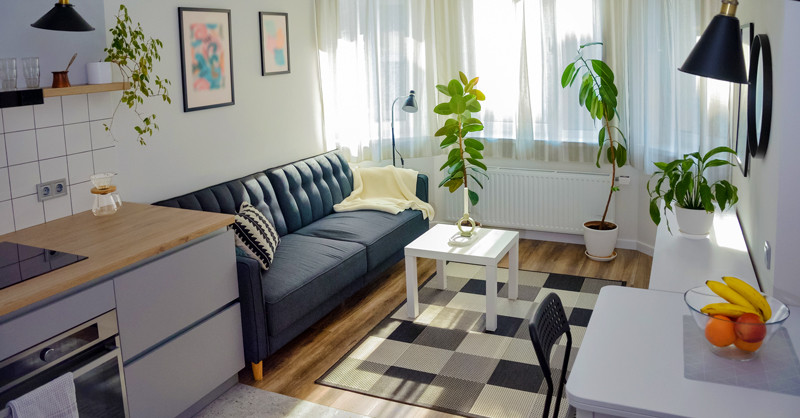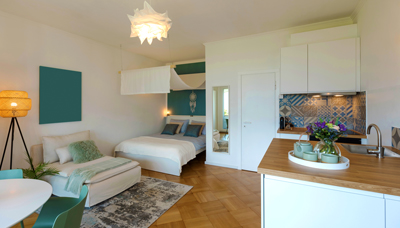
Microapartments are small, partially or fully self-contained residential spaces that can be purpose-built or created by subdividing an existing property.
While all residential tenancy agreements in Queensland are covered under the Residential Tenancies and Rooming Accommodation Act 2008 (the Act), how the Act applies to microapartments can depend on a variety of factors and the type of tenancy agreement in place.
If you’re a property manager/owner or tenant/resident looking to rent a microapartment, it’s important to understand the laws that apply.
What is a microapartment?
Buildings, an international research journal, notes microapartments are generally smaller than a standard studio apartment and usually no bigger than 35–40 square metres. They often have their own entrance, a dedicated space for living/sleeping, a bathroom and place to cook such as a kitchenette (read more: Buildings, Inside a Microapartment: Design Solutions to Support Future Sustainable Lifestyles).
Microapartments may be fully or partially self-contained, sometimes sharing facilities such as a kitchen with other microapartments. They can be purpose-built or created by subdividing an existing property.

Microapartments typically have one main living/sleeping area that may include a kitchenette, and a private bathroom.
Bonds for microapartments
If a rental bond is taken for a microapartment tenancy, it must be lodged with the RTA regardless of the tenancy type or features of the complex. Failure to lodge a bond for a general tenancy or rooming accommodation agreement within 10 days is an offence under the Act.
Tenancy agreements for microapartments
The property manager/owner of a microapartment must provide a written tenancy agreement for tenancies covered under the Act. The type of agreement that applies can depend on what is included in an individual microapartment, what facilities are shared and whether the owner lives at the property.
Fully self-contained
A fully self-contained microapartment includes its own kitchen and bathroom facilities. Where a microapartment meets the criteria of being fully self-contained, it is typically managed under a general tenancy agreement.
If a microapartment is part of a larger complex, general tenancies may also be subject to body corporate by-laws.
Helpful resources for general tenancies include the Managing general tenancies in Queensland for property managers/owners and the Pocket guide for tenants – houses and units (Form 17a).
Partially self-contained
A partially self-contained microapartment may have its own bathroom or kitchenette while also sharing some key facilities with other microapartments, such as a communal kitchen or bathroom. If a microapartment shares facilities, it may be appropriate for property managers/owners to provide residents with a rooming accommodation agreement.
Rooming accommodation agreements can be used when a resident:
- has a right to occupy one or more rooms (including their own microapartment)
- does not have a right to occupy the whole of the premises in which the microapartment is situated
- does not occupy a self-contained microapartment
- shares other rooms, or facilities outside of their microapartment (with one or more of the other residents).
Rooming accommodation agreements are covered under specific criteria in the Act, and residents are required to follow house rules set by the property manager/owner.
In some situations, even when a microapartment meets the criteria for rooming accommodation, a resident and a provider can choose to enter into a general tenancy agreement instead.
For rooming accommodation, the RTA has dedicated forms and fact sheets. The Managing rooming accommodation in Queensland guide is a helpful resource for property managers/owners.
Owner lives at the property
If an owner rents out part of their property while also living there, such as when a house has been subdivided into microapartments, there are several factors that determine how the Act applies and what agreement may be required. The RTA’s guide on Owner-occupiers renting out rooms covers the different scenarios.
Check your agreement type
It’s important for tenants/residents to check what type of written agreement is in place. General tenancy agreements and rooming accommodation agreements have different rights and obligations, such as different notice periods for certain actions.
If a property manager/owner and tenant/resident of a microapartment disagree about what kind of agreement applies and are unable to resolve the issue themselves, they can make an urgent application to the Queensland Civil and Administrative Tribunal (QCAT) for a determination.
Be a good neighbour
If you’re a tenant/resident in a microapartment, you’ll likely get to know your neighbours through communal spaces in the property. Being part of a tight-knit community can be rewarding, but greater consideration is needed when sharing spaces or living in close proximity to others. For more tips, read the RTA’s guide to being a good neighbour.
Note: While the RTA makes every reasonable effort to ensure that information on this website is accurate at the time of publication, changes in circumstances after publication may impact on the accuracy of material. This disclaimer is in addition to and does not limit the application of the Residential Tenancies Authority website disclaimer.

